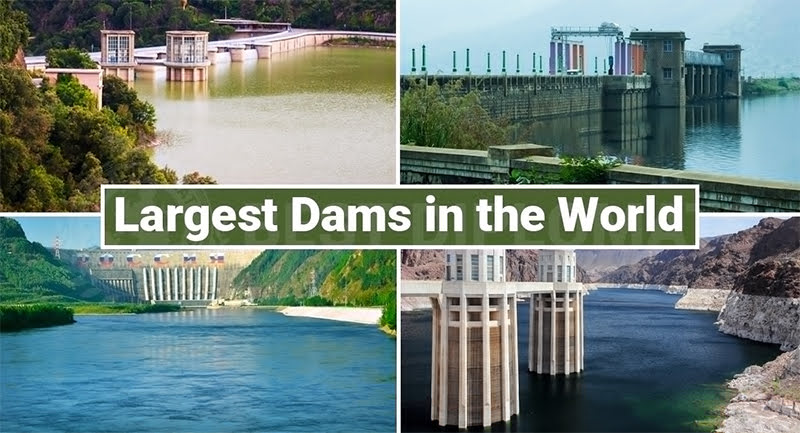The hydroelectric Kariba dam, which is located between Zambia and Zimbabwe, is the largest dam in the world. There are numerous dams worldwide that provide a natural view of the natural world. In addition to being a work of engineering, the Kariba dam represents unity. The Zambezi River’s flow is controlled by Kariba Dam, which also prevents floods during the rainy season. because the dam was built in 1959.
Largest Dams In The World in 2024
Hydroelectric dams, whether they are gravity, embankment, or arch, are among the most powerful infrastructures ever constructed. These goliath structures act as hindrances to limit or end the progression of waterways or groundwater streams, making huge repositories. Albeit the idea of dams traces all the way back to antiquated times, when they were developed utilizing earth or shakes, present day dams are worked with concrete and other high level structure materials.
Read More:-
Universal Account Number (UAN) Login
Which is The Largest Dam in The World?
The criteria you take into account, such as the reservoir’s capacity, dam height, volume of construction materials, and installed power plant’s capacity, or the actual generation of energy, determine which dam is the largest in the world.
- Kariba Dam in Zambia: The Kariba Dam is regarded as the largest dam in the world in terms of reservoir capacity. The reservoir at the Kariba dam in Zambia has a capacity of 180,600 hm3.
- Rogun Dam in Tajikistan: The Rogun Dam in Tajikistan, which is on the Vakhsh River and is expected to be 335 meters tall, is currently being built.
- Syncrude Tailings Dam in Canada: With 540.000.000 m3 of construction materials, the Syncrude Tailings Dam is the largest dam in the world in terms of volume. To make the Syncrude Tailings Dam as stable as possible, compacted dirt from mining operations is being used to build it.
- Three Gorges Dam in China: With an installed capacity of 22,500 MW, China’s Three Gorges Dam on the Yangtze River houses the largest hydroelectric plant in the world.
- Itaipu Dam between Brazil and Paraguay: The Itaipu Dam on the Paraná River, which is the first hydropower generation facility in the world, is on the border between Brazil and Paraguay. The Itaipu Dam generates approximately 98,000 GWh annually and has an installed capacity of 14,000 MW.
Read More:-
What Is The Largest Dam in the World?
For instance, while some individuals are more interested in the dam with the largest surface area, others are more interested in the dam with the greatest storage capacity. Lake Kariba is created by it, which can be found in the Kariwa Gorge. The dam has a capacity limit of roughly 185 billion cubic meters of water. Additionally, the region has a surface area of over 5,500 square kilometers. The dam is overseen by the Zambezi Waterway Authority and it was worked somewhere in the range of 1955 and 1959.
How Large Is The Three Gorges Dam?
Another significant dam that spans the Yangtze River is the Three Gorges Dam in China. It is one of the most popular tourist destinations in the Hubei region and can be found in Yichang. With a capacity of 22,500 MW, it has been estimated that the dam is the largest power station in the world in terms of electric capacity. Depending on the quantity of water in the river basin, the dam generates 95 TWh of annual electricity.
How Large Is The Hoover Dam?
At one point, the Hoover Dam was one of the world’s largest dams. It was built during the 1930s, and it addresses an image of American industry. It was built during the Great Depression, and many people got jobs there that helped them feed their families. There are still great many individuals who stay with the dam consistently, despite the fact that it has been shut to guests during the pandemic. The construction of the dam, which is on the Nevada and Georgia borders, took about five years.
Read More:-
What Is The Largest Dam in The United States?
The fact that the Hoover Dam is not the largest dam in the nation surprises some people. The Fort Peck Dam in northeastern Montana, on the Missouri River, holds that title. Near Fort Peck, the dam has a height of 250 feet and a length of 21,000 feet. Fort Peck Lake is the result of the dam.
Final Words
To span rivers or estuaries, dams are among the most massive human-made structures. Typically, they require millions of tonnes of soil, concrete, rocks, and other materials. They do a lot of important things, like keeping water for people to drink and use for irrigation, controlling floods, making hydroelectric power, and making it easier to move water and have fun. Dams have become essential to both local communities and larger industrial endeavors because of their numerous functions.
